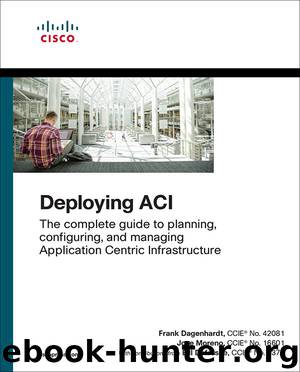Deploying ACI: The complete guide to planning, configuring, and managing Application Centric Infrastructure by Frank Dagenhardt & Jose Moreno & Bill Dufresne

Author:Frank Dagenhardt & Jose Moreno & Bill Dufresne [Dagenhardt, Frank]
Language: eng
Format: epub
Publisher: Pearson Education
Published: 2018-02-11T23:00:00+00:00
This is an extremely important aspect of Cisco ACI. Not only does the network admin reduce some load, through externalizing routine operations such as checking the state of the network or a switch port, but the network becomes more agile and more relevant than ever, because it gets into the hands of the people who are actually using it.
Let’s look at an example: You go a restaurant and want to order some food, but no waiter is available. You wait, and wait, and wait, but no waiter comes; they seem to be extremely busy with other tables. Maybe a waiter will eventually take your order, or maybe you will leave that restaurant frustrated. No matter how good the food is, chances are you will never come back to that restaurant again. But now imagine you can order using your mobile phone, and your food gets to your table a few minutes later. By changing the consumption model, the customer experience has been dramatically improved.
But wait a second; in this example the waiters are replaced by an ordering mobile app. Are we saying that network admins are doomed to disappear? By no means—the point is that routine activities that deliver no added value to an organization will be automated, so that network administrators will have more time to concentrate in other high-touch activities such as architecture design and troubleshooting.
Depending on the network activity you want to externalize (that is, give to others to run on their own), you might use different techniques:
For virtualization administrators, you might want to leverage ACI’s VMM integration. For example, through the integration with OpenStack, Horizon users can create applications and EPGs in ACI directly from the tool they are used to working with, without having to reach out to the network admin. Similar effects can be achieved with the VMware vCenter plug-in or integration with Microsoft System Center VMM, for other hypervisors. Refer to Chapter 4, “Integration of Virtualization Technologies with ACI,” for more information.
Another possibility for giving more direct network consumption to other groups in your organization is through the management multi-tenancy and role-based access control (RBAC), as Chapter 9 describes in detail. You can grant access to the Cisco ACI GUI to people interested in certain applications so that they can quickly check the state of the network (for example, by looking at the dashboards, as described in this chapter). Through RBAC, you can make sure those individuals are not able to execute operations that they shouldn’t, such as modifying the network configuration. For example, think about storage administrators being able to verify on their own whether the network or something else is the reason for a storage performance issue, without having to talk to the networking team.
Finally, for more complex tasks, you might want to leverage Cisco ACI’s programmability, in order to integrate other people’s tools within the network, so that network configuration is integrated into their existing processes. Chapter 13, “ACI Programmability,” goes into this area in greater detail and includes practical examples.
Download
This site does not store any files on its server. We only index and link to content provided by other sites. Please contact the content providers to delete copyright contents if any and email us, we'll remove relevant links or contents immediately.
Sass and Compass in Action by Wynn Netherland Nathan Weizenbaum Chris Eppstein Brandon Mathis(7968)
Grails in Action by Glen Smith Peter Ledbrook(7940)
Configuring Windows Server Hybrid Advanced Services Exam Ref AZ-801 by Chris Gill(7339)
Azure Containers Explained by Wesley Haakman & Richard Hooper(7323)
Running Windows Containers on AWS by Marcio Morales(6872)
Kotlin in Action by Dmitry Jemerov(5367)
Microsoft 365 Identity and Services Exam Guide MS-100 by Aaron Guilmette(5340)
Microsoft Cybersecurity Architect Exam Ref SC-100 by Dwayne Natwick(5104)
Combating Crime on the Dark Web by Nearchos Nearchou(4916)
The Ruby Workshop by Akshat Paul Peter Philips Dániel Szabó and Cheyne Wallace(4609)
Management Strategies for the Cloud Revolution: How Cloud Computing Is Transforming Business and Why You Can't Afford to Be Left Behind by Charles Babcock(4510)
The Age of Surveillance Capitalism by Shoshana Zuboff(4192)
Python for Security and Networking - Third Edition by José Manuel Ortega(4177)
Learn Wireshark by Lisa Bock(4020)
The Ultimate Docker Container Book by Schenker Gabriel N.;(3833)
Learn Windows PowerShell in a Month of Lunches by Don Jones(3587)
DevSecOps in Practice with VMware Tanzu by Parth Pandit & Robert Hardt(3504)
Windows Ransomware Detection and Protection by Marius Sandbu(3497)
Blockchain Basics by Daniel Drescher(3474)
